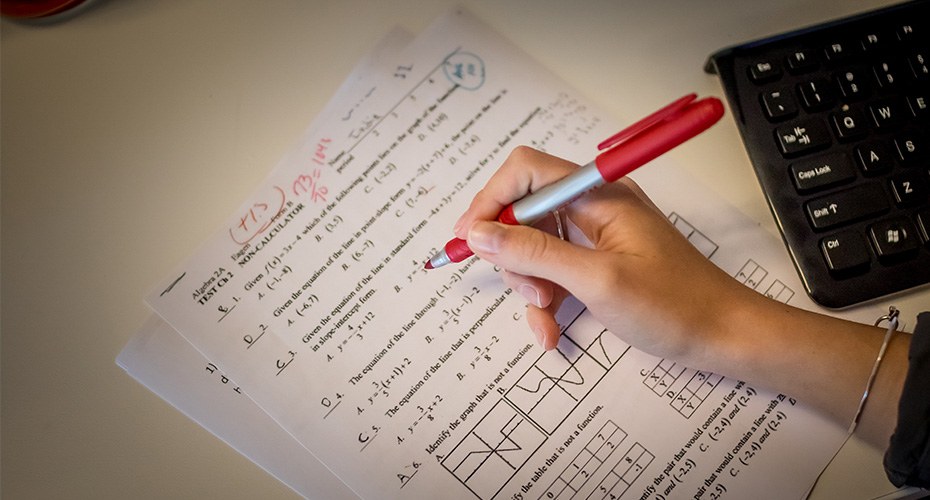How experienced math teachers use real-world applications to enhance student understanding
Wiki Article
Accomplishing Enterprise Quality: Recognizing Industry Standards and Strategic Leadership for Mathematics Professors
Attaining business quality in maths education requires a careful evaluation of industry criteria and the duty of calculated leadership. Mathematics faculty need to comprehend how these requirements shape educational program and mentor methods. Additionally, efficient management can drive partnership and expert growth amongst instructors. This diverse strategy increases inquiries about the sensible effects for trainees' profession preparedness. What techniques can faculty take on to link the void in between education and learning and market needs?The Value of Sector Standards in Mathematics Education
In the domain name of mathematics education, adhering to industry requirements is necessary for ensuring that programs successfully prepare students for real-world applications. Sector criteria give a structure that aligns educational results with the skills needed in various careers. By including these standards, mathematics programs can boost their importance and rigor, therefore enhancing trainee interaction and discovering outcomes.
Strategic Leadership: Specifying Responsibilities and roles
Reliable calculated management within mathematics professors needs a clear definition of duties and roles to ensure ideal working and positioning with institutional objectives. Leadership frameworks have to be developed to define tasks among faculty participants, managers, and support personnel, ensuring that each individual understands their payments toward cumulative objectives. Professors leaders need to cultivate a setting that advertises cooperation and accountability, making it possible for staff member to involve efficiently in educational program development and evaluation procedures.Tactical leaders need to focus on ongoing expert growth, making sure that faculty members are well-appointed to fulfill the advancing needs of maths education and learning. This involves not only aligning specific functions with institutional top priorities however likewise fostering a society of constant improvement and advancement. By clearly defining functions, critical leadership can enhance communication, improve decision-making procedures, and ultimately add to a much more natural and effective maths professors, positioned to fulfill the challenges of modern-day education and learning.
Ideal Practices for Enhancing Mentor and Discovering
In the pursuit of enhancing mentor and understanding, mathematics faculty can profit from cutting-edge mentor methods that engage students successfully. Applying joint learning settings promotes synergy and essential thinking skills among students. These best practices are necessary for creating a dynamic academic experience that advertises deeper understanding of mathematical principles.Cutting-edge Teaching Strategies
While standard methods of teaching have their area, innovative mentor strategies are essential for boosting engagement and understanding amongst maths professors and their students. Methods such as turned classrooms and problem-based learning urge active participation, allowing trainees to take ownership of their understanding. Incorporating modern technology, such as interactive simulations and on-line partnership devices, further supports varied learning designs and promotes essential thinking. Furthermore, using real-world applications in lessons assists trainees attach mathematical ideas to everyday life, making the topic extra enticing and appropriate. Faculty participants that embrace these strategies can produce a vibrant knowing setting that not just enhances comprehension but additionally motivates a lifelong interest for maths. Embracing innovative approaches eventually brings about greater levels of trainee accomplishment.
Collaborative Learning Atmospheres
Structure on the cutting-edge training approaches formerly reviewed, collaborative understanding atmospheres play an essential role in improving the instructional experience for mathematics faculty and their pupils. These settings encourage energetic involvement and promote a sense of neighborhood, allowing trainees to pick up from one another and create vital thinking skills. Finest methods include structured group job, peer tutoring, and project-based knowing, which promote collaboration and shared obligation for learning end results. Faculty ought to help with conversations and provide support while permitting trainees to check out ideas collectively. Furthermore, integrating technology can enhance cooperation by offering systems for interaction and resource sharing. Eventually, joint knowing settings encourage students to take possession of their education and click resources learning and grow a deeper understanding of mathematical ideas through team effort and communication.
Aligning Professors Goals With Institutional Goals
Straightening professors goals with institutional goals is essential for promoting a cohesive educational environment that improves both teaching performance and pupil success. When faculty participants understand and accept the broader objective of their organization, their teaching techniques can be tailored to support these goals. This positioning guarantees that faculty are not just fulfilling department expectations but likewise adding to the overarching goals of the organization, such as enhancing trainee engagement and academic performance.To achieve this placement, normal interaction in between professors and management is vital. Workshops and collective meetings can help with conversations on institutional priorities and how faculty can incorporate these into their educational program. Furthermore, efficiency evaluations can be made to reflect these aligned goals, urging professors to innovate in their training approaches. Eventually, when faculty goals resonate with institutional goals, they grow an extra unified method to education, profiting both students and instructors alike.
Cultivating a Culture of Continuous Renovation
Cultivating a culture of continuous renovation within mathematics faculty is important for enhancing both educational quality and student end results. This involves creating an atmosphere where professor are motivated to on a regular basis evaluate their mentor techniques and look for comments. Specialist advancement opportunities should be offered, allowing educators to discover brand-new pedagogical methods and integrate evidence-based techniques right into their curriculum.Cooperation amongst faculty is vital; sharing experiences and insights can lead to innovative options and improved mentor methods. Institutions ought to implement organized evaluation processes, making it possible for faculty to assess their performance and determine areas for development.
Identifying and celebrating accomplishments, no matter just how small, reinforces the dedication to improvement. By installing continual improvement right into the faculty society, math departments can enhance their general efficiency, ultimately profiting both instructors and trainees in the pursuit of scholastic excellence.
Innovative Methods to Mathematics Program Advancement
Many ingenious approaches can transform mathematics program development, making it more receptive to the evolving educational landscape. click here to read experienced math teachers. One reliable strategy includes incorporating modern technology, such as on the internet knowing platforms and interactive software application, to boost student interaction and accessibility. This change enables a blended knowing setting, dealing with varied learning stylesEmbracing a project-based learning framework encourages collaborative analytic and real-world application of mathematical concepts. Professors can also highlight interdisciplinary links, showing how mathematics converges with fields like science, design, and art, fostering a more all natural academic experience.
Normal feedback from pupils and industry stakeholders can guide educational program changes, ensuring significance and roughness. Furthermore, providing expert growth possibilities for professors can promote ingenious teaching techniques and maintain educators notified of the current fads. Through these approaches, mathematics programs can cultivate a dynamic learning ambience that prepares trainees for future difficulties and occupations.
Often Asked Inquiries
Just How Can Faculty Measure the Influence of Market Standards on Trainee Outcomes?
Faculty can measure the impact of sector criteria on student end results by assessing evaluation outcomes, tracking employment prices, obtaining company comments, and performing longitudinal studies to compare student efficiency before and after applying the criteria.What Resources Are Readily Available for Professional Advancement in Mathematics Education?
Numerous resources for expert advancement in maths education and learning consist of online training courses, workshops, webinars, expert organizations, conferences, and peer partnership chances. These platforms promote skill enhancement, innovative teaching strategies, and reliable assimilation of technology into mathematics instruction.Just How Do Sector Standards Vary Across Different Geographical Areas?
Market standards vary substantially across geographical areas as a result of factors like governmental regulations, instructional concerns, and cultural impacts. These disparities can influence educational program development, teaching methods, and the execution of evaluation techniques in maths education.What Role Does Modern Technology Play in Achieving Business Quality in Mathematics?
Technology improves venture excellence in mathematics by improving processes, making it possible for information analysis, promoting collaboration, and providing accessibility to resources. It equips teachers and students alike, promoting innovative training techniques and improving general instructional outcomes in the area.Just How Can Professors Effectively Collaborate With Sector Partners?

In the search of boosting training and learning, mathematics professors can benefit from cutting-edge mentor methods that engage students properly. While traditional approaches of teaching have their area, innovative training strategies are important for boosting interaction and understanding amongst maths professors and their students. Structure on the innovative training approaches formerly talked about, collective understanding settings play an essential role in boosting the academic experience for mathematics professors and their trainees. Lining up professors goals with institutional purposes is essential for promoting a natural educational setting that enhances both training effectiveness and pupil success. Promoting a society of continual enhancement within maths faculty is necessary for improving both training quality and pupil end results.
Report this wiki page